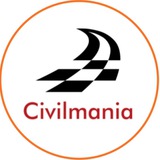✨Slipform construction technique✨
▪️It is an alternative for conventional formwork system which helps in continuous vertical and horizontal construction.
▪️The slipform helps to conduct continuous pouring of the concrete to the moving formwork. The process stops only when the required length of casting is completed.
📌Advantages of Slipform Construction Technique
▪️Non-stop Method of Construction
▪️Increase rate of construction
▪️Increase the productivity
▪️Provide more working space
▪️Creates safe work environment for the workers
▪️Employs less accessory equipment
▪️Increase flexibility in construction
▪️Reduced Labor costs
▪️Scaffolding and temporary works in construction is reduced
▪️Uniform wall sections and layouts are obtained
📌Applications
▪️High rise structures
▪️ Chimney Construction
▪️ Construction of steel tanks
▪️ Construction of water Towers
▪️It is an alternative for conventional formwork system which helps in continuous vertical and horizontal construction.
▪️The slipform helps to conduct continuous pouring of the concrete to the moving formwork. The process stops only when the required length of casting is completed.
📌Advantages of Slipform Construction Technique
▪️Non-stop Method of Construction
▪️Increase rate of construction
▪️Increase the productivity
▪️Provide more working space
▪️Creates safe work environment for the workers
▪️Employs less accessory equipment
▪️Increase flexibility in construction
▪️Reduced Labor costs
▪️Scaffolding and temporary works in construction is reduced
▪️Uniform wall sections and layouts are obtained
📌Applications
▪️High rise structures
▪️ Chimney Construction
▪️ Construction of steel tanks
▪️ Construction of water Towers
📌End bearing pile
▪️When piles transfer load of the building through a soft soil strata to a suitable bearing stratum at greater depths then it is called a bearing pile
▪️The load is taken by the HARD STRATA.
▪️Hard strata is essentially required
▪️It is used to transfer load through water or soft soil
📌Friction Piles
▪️ When piles transfer the loads only by means of skin resistance without any end bearing then the piles are called as friction piles.
▪️ Load is taken by the FRICTION developed between side of the pile and surrounding ground
▪️Hard strata is not essentially required
▪️It is used to transfer loads through a depth of friction
▪️When piles transfer load of the building through a soft soil strata to a suitable bearing stratum at greater depths then it is called a bearing pile
▪️The load is taken by the HARD STRATA.
▪️Hard strata is essentially required
▪️It is used to transfer load through water or soft soil
📌Friction Piles
▪️ When piles transfer the loads only by means of skin resistance without any end bearing then the piles are called as friction piles.
▪️ Load is taken by the FRICTION developed between side of the pile and surrounding ground
▪️Hard strata is not essentially required
▪️It is used to transfer loads through a depth of friction
✨Culvert✨
Culvert is defined as a TUNNEL STRUCTURE constructed under roadways or railways to provide cross drainage or to take electrical or other cables from one side to other.
It is totally enclosed by soil or ground.
📌Common types of Culvert :-
Pipe culvert, Box culvert and arch culvert are the common types used under roadways and railways.
📌Location of Culverts
▪️The location of culverts should be based on economy and usage.
▪️Generally it is recommended that the provision of culverts under roadway or railway are economical.
▪️There is no need to construct separate embankment or anything for providing culverts.
▪️The provided culverts should be perpendicular to the roadway.
▪️It should be of greater dimensions to allow maximum water level and should be located in such a way that flow should be easily done.
▪️It is possible by providing required gradient.
Culvert is defined as a TUNNEL STRUCTURE constructed under roadways or railways to provide cross drainage or to take electrical or other cables from one side to other.
It is totally enclosed by soil or ground.
📌Common types of Culvert :-
Pipe culvert, Box culvert and arch culvert are the common types used under roadways and railways.
📌Location of Culverts
▪️The location of culverts should be based on economy and usage.
▪️Generally it is recommended that the provision of culverts under roadway or railway are economical.
▪️There is no need to construct separate embankment or anything for providing culverts.
▪️The provided culverts should be perpendicular to the roadway.
▪️It should be of greater dimensions to allow maximum water level and should be located in such a way that flow should be easily done.
▪️It is possible by providing required gradient.
✨Pune Municipal Corporation Advertisement✨
Total: 25 Posts
Name of the Post: Junior Engineer (Civil)
Educational Qualification:
(i) Civil Engineering Degree/ Diploma
(ii) 3 years experience
Age Limit: 18 to 38 years as on 16 January 2020 [Reserved Category: 05 years Relaxation]
Job Location: Pune
Fee: No fee.
Address to Submit the Application:City Engineer’s Office, Room No. 103, 1st Floor Pune Municipal Main Building, Shivajinagar. Pune – 411005
Last Date of Submission of Application: 31 January 2020
Total: 25 Posts
Name of the Post: Junior Engineer (Civil)
Educational Qualification:
(i) Civil Engineering Degree/ Diploma
(ii) 3 years experience
Age Limit: 18 to 38 years as on 16 January 2020 [Reserved Category: 05 years Relaxation]
Job Location: Pune
Fee: No fee.
Address to Submit the Application:City Engineer’s Office, Room No. 103, 1st Floor Pune Municipal Main Building, Shivajinagar. Pune – 411005
Last Date of Submission of Application: 31 January 2020
